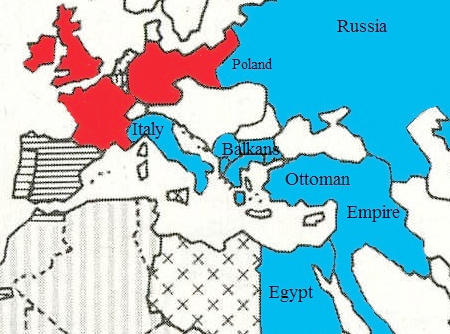Collaborative Research Project "Making War, Mapping Europe: Militarized Cultural Encounters, 1792-1920"
Warfare and cultural encounters
Warfare has been one of the most significant but overlooked engines of cultural encounter in modern European history. The era of mass armies inaugurated by the French Revolution involved millions in cultural encounters to which they would not otherwise have been exposed. During the Napoleonic Wars and the First World War, and at many points between, hundreds of thousands embarked on military expeditions to distant places both within Europe and on Europe’s periphery. Warfare has thus created extended ‘contact zones’ in which cultural exchanges and engagements (as well as acts of violence and brutality) have taken place.
Through a series of interlocking case-studies focusing on encounters between Western European armies (British, French and German) and the peoples and cultures of Eastern Europe, the Balkans, the Mediterranean and the Middle East, the collaborative research project has explored the distinctive characteristics of militarized cultural encounters and how they have shaped the collective mental map of Europe and its borders between 1792 and 1920.
Individual projects
Freie Universität Berlin:
German Soldiers in the Ottoman Empire, 1835-1918
Trinity College Dublin:
French Military Expeditions in Italy (1796-99) and Egypt (1798-1801)
British and French Expeditions to Italy, the Balkans and the Near East (1915-20)
University of York:
The Visual and Material Culture of British Military Encounters with Egypt, 1798-1918
University of Swansea:
German Military Encounters with Eastern Europe: Experience and Commemoration, 1812-1914

Zones of contact researched by the projects
Aims and objectives
The guiding question of the project concerned the extent to which mass military cultural encounters helped to shape collective perceptions of ‘the self’ and ‘the other’, of Europe and its borders in the period 1792-1920. Among the key research questions that the collaborative research project addressed were:
- How have these militarized encounters contributed to the crystallization, transformation and popularization of modern conceptions and representations of Europe and its others? What does the textual, visual and material record of militarized cultural encounter tell us about how the mental maps of Europe and its borders have evolved over time and between countries?
- How might the categorization of the soldier as a traveller or tourist change and enrich our understanding of both the history of war experience and the history of travel? What conventions do war narratives share with genres of travel writing such as the picturesque, the pilgrimage and ethnographic surveys? What has been the relationship between military modes of viewing and the ‘tourist gaze’? Can a distinctive ‘military ethnography’ be identified?
- What are the distinctive features of militarized cultural encounters and how have they differed from other large-scale movements of people? To what extent have these cross-cultural contacts been shaped by military imperatives such as the need for inter-military co-operation and the inter-cultural competence required of military staff? Were soldiers’ reactions shaped by common military needs or by a specific national military culture?
The project therefore dealt with the emergence of shared imaginings, stereotypes and discourses and personal encounters with foreign cultures normally resulting in a differentiation or transformation of these pre-existent images. These processes were studied with regard to a long-term process of experience, which encompasses the period prior to and after the encounter. The project approached its subject through five micro studies that focused on significant examples of cultural encounter. This allowed comparison of the conditions, the forms and the outcomes of cross-cultural contact on three different levels: synchronically through comparison of different armies and nationalities; spatially through the comparison of different cultural spaces and zones of contact; and finally diachronically through a comparison within the ‘long 19th century’, from the Revolutionary Wars to the First World War.
The ambition of the study was to develop an empirically grounded framework for understanding the elaboration, transformation and transmission of images of Western European ‘selves’ and their ‘others’ at the level of both collective perception and individual experience.